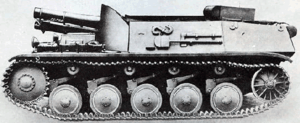15 cm sIG 33 auf Fahrgestell Panzerkampfwagen II (Sf)
The 15 cm sIG 33 auf Fahrgestell Panzerkampfwagen II (Sf), sometimes referred to as the Sturmpanzer II Bison, was a German assault gun used during World War II.
| 15 cm sIG 33 auf Fahrgestell Panzerkampfwagen II (Sf) | |
|---|---|
 Side view of the prototype | |
| Type | Heavy assault gun |
| Place of origin | Nazi Germany |
| Service history | |
| In service | 1942 - 1943 |
| Used by | Nazi Germany Egypt 1948 |
| Wars | World War II Israeli War of Independence 1948 |
| Production history | |
| Manufacturer | Alkett |
| Produced | 1941 |
| No. built | 12 |
| Specifications | |
| Mass | 11.2 tonnes (11.0 long tons; 12.3 short tons) |
| Length | 5.41 metres (17.7 ft) |
| Width | 2.6 metres (8.5 ft) |
| Height | 1.9 metres (6.2 ft) |
| Crew | 4 |
| Armor | 30 mm - 5 mm |
Main armament | 1× 15 cm sIG 33 |
Secondary armament | 1× 7.92 mm Maschinengewehr 34 |
| Engine | Bussing-NAG engine |
| Transmission | 6 forward, 1 reverse gears |
| Suspension | leaf-spring |
Operational range | 190 kilometres (120 mi) |
| Maximum speed | 40 kilometres per hour (25 mph) |
Development
The 15 cm sIG 33 (Sf) auf Panzerkampfwagen I Ausf B that had participated in the Invasion of France in 1940 had proven to be too heavy for its chassis as well as being enormously tall.
The same gun was mated to the Panzerkampfwagen II chassis in an attempt to drastically lower its height while using a stronger chassis. The prototype used a standard Panzer II Ausf. B chassis when it was built in February 1941, but this was too cramped for use.[1] The chassis was lengthened by 60 centimetres (24 in), which required adding a sixth roadwheel, and widened by 32 centimetres (13 in) to better accommodate the gun while preserving its low silhouette. 15-millimetre (0.59 in) plates formed the front and sides of the open-topped fighting compartment,[1] which was also open at the rear. Its sides were notably lower than the front, which made the crew vulnerable to small arms fire and shell fragments. Large hatches were added to the rear deck to better cool the engine.
The 15-centimetre (5.9 in) sIG 33 gun was used to act as close support artillery and infantry support, for which 30 rounds were carried, could traverse a total of 5° left and right and used a Rblf36 sight.
Combat use

Twelve were built at the end of 1941. In early 1942, they were shipped to North Africa, where they formed schwere Infanteriegeschütz-Kompanien (mot.S.) ("Heavy Self-propelled Infantry Gun Companies") 707 and 708. They were used as close support mobile artillery, with the former assigned to Schützen-Regiment 155 and the latter to Schützen-Regiment 200, both part of the 90. leichte Afrika-Division.[2] Both companies fought until the Axis surrender in Tunisia in May 1943.
References
Notes
- Rickard, John. "15cm slG33 auf Fahrgestell Panzerkampfwagen II (Sf)". historyofwar.org. Retrieved 29 July 2014.
- Trojca & Jaugitz, p. 5
Bibliography
- Chamberlain, Peter, and Hilary L. Doyle. Thomas L. Jentz (Technical Editor). Encyclopedia of German Tanks of World War Two: A Complete Illustrated Directory of German Battle Tanks, Armoured Cars, Self-propelled Guns, and Semi-tracked Vehicles, 1933–1945. London: Arms and Armour Press, 1978 (revised edition 1993) ISBN 1-85409-214-6
- Trojca, Waldemar and Jaugitz, Markus. Sturmtiger and Sturmpanzer in Combat. Katowice, Poland: Model Hobby, 2008 ISBN 978-83-60041-29-1
External links
- Panzers of the Reich
- wwiivehicles.com
- "Gw. II für 15 cm s.I.G. 33: S.P. Heavy Infantry Howitzer" (U.S. World War II intelligence report)